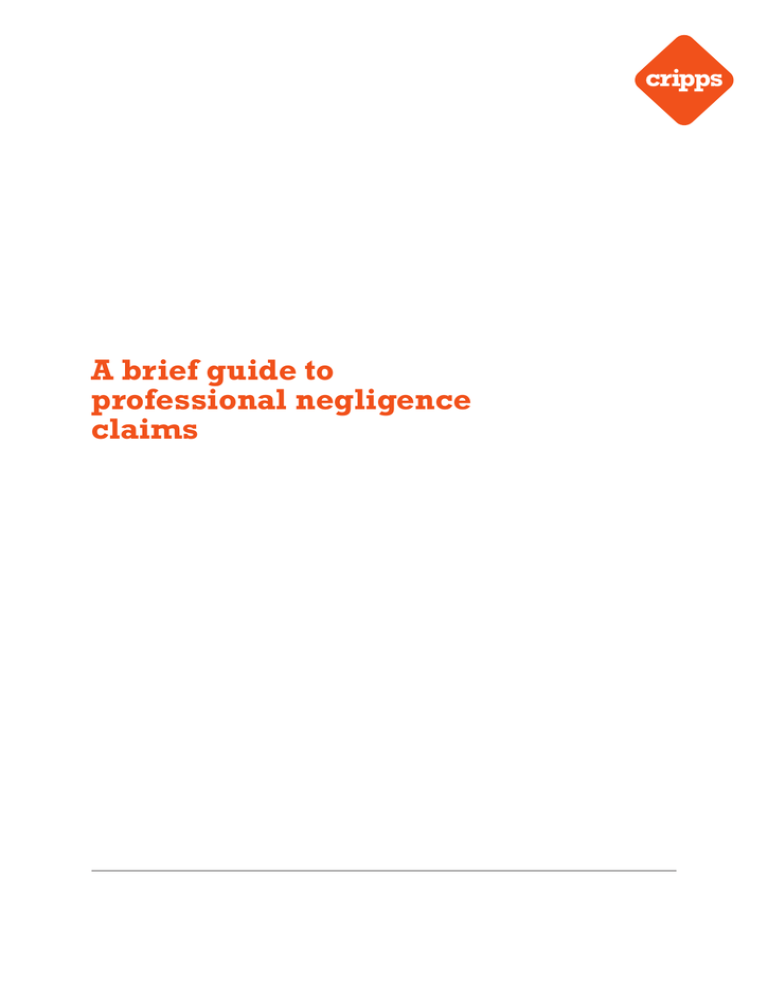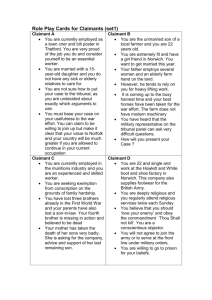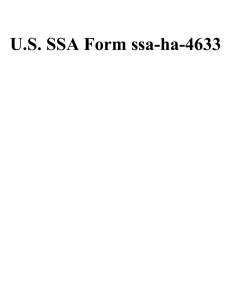A brief guide to professional negligence claims
advertisement

A brief guide to professional negligence claims Contents Introduction Do I have a claim? Important considerations Pre-action protocol procedure Court proceedings Contact information Introduction Claims against professionals, such as accountants, financial advisers, solicitors, surveyors and architects, have become more common in recent years. This is due to a combination of factors including an increasing reliance upon professional advice, the complexity of work carried out, and a raised awareness of legal rights. In addition, in times of economic downturn, losses suffered are often more apparent. Professional negligence claims can be complex and it is important to seek advice from specialist solicitors who are experienced in dealing with this type of claim. This guide is intended to be a brief overview of some of the important considerations and procedures when embarking upon a professional negligence claim. It is not a substitute for legal advice. If you would like to have a free no obligation discussion with a solicitor experienced in professional negligence claims, please contact us using the details below. Russell Simpson Partner T +44 (0)1892 506 139 E russell.simpson@cripps.co.uk Do I have a claim? A successful claimant will need to demonstrate that he or she was owed a duty of care by the defendant professional, the professional breached the duty of care, and the breach caused a loss to the claimant. Duty of care A professional may owe various duties to the claimant. Sometimes this will be obvious, for example where there is a written retainer or agreement between a professional and a client. However, there does not always need to be a written agreement and a professional holding himself or herself out to have particular expertise and advising the client may be assuming duties towards the client. Usually, but not always, a claimant will be the person who has instructed the professional, although in some circumstances (such as a solicitor preparing a Will) the professional can owe duties to a third party. Breach of duty A professional who gives advice which later turns out to be wrong is not necessarily negligent. The claimant will need to demonstrate that the professional fell below the standards of a reasonably competent professional, having regard to the standards normally expected in his profession. For example, a solicitor holding himself out to be a specialist conveyancing solicitor is required to comply with the standards expected of a reasonably competent conveyancing solicitor. The particular experience of the professional, who may be a newly qualified solicitor or a senior partner, does not affect this standard. If there is a difference of opinion within the profession as to the correct practice, the professional will be able to demonstrate that he has not breached the duty of care if he can show that he acted in a way which was regarded as proper by a reasonable body of professional opinion. It is interesting to note how the courts have dealt with allegations of negligence arising from property valuations. The valuation process does not produce precise answers, and different valuers may produce different valuations but without necessarily being negligent. The court’s approach is to identify a range, or bracket, of acceptable values and, if the valuation falls within this range, then the valuer will not be negligent. Causation One of the most important hurdles for the successful claimant is to demonstrate that he or she has suffered loss as a result of the negligence. A professional may have been negligent, but if this did not cause the loss, then there will be no claim. For example, a claimant may have received negligent advice but if he did not rely on it, then a claim will not succeed. The particular circumstances of a claim can be complex and a large body of case law has developed in relation to causation. Often the starting point is the ‘but for’ test. If the loss would have occurred in any event, then the breach cannot be said to have caused the loss. In other words, what would have happened ‘but for’ the negligence? For example, a conveyancing solicitor fails to spot a problem with a property for a buyer client, such as a lack of planning permission or buildings regulations. If the solicitor had properly advised the client, would he still have gone ahead with the purchase? Other factors may also need to be considered. For example there may be an intervening act by the claimant or by a third party which ‘breaks the chain of causation’. Similarly, the loss may have a number of causes and the claimant will need to demonstrate that the negligence was the main cause, or a material cause, of the loss in order for the claim to be successful. Loss The correct measure of a claimant’s loss is tied in to issues of causation and can also be a complex issue. However, the basic principle is to put the claimant into the position he would have been in had the professional not breached the duty owed to the claimant. For example, if a surveyor overvalues a property for a client who purchases it on the basis of that valuation, the starting point to calculate the loss is likely to be the valuation price paid less the true market value at the time. A claimant has a duty to mitigate his losses. A claimant cannot recover damages for losses which could have been avoided by taking reasonable steps. Likewise, a claimant will not recover the increased losses where unreasonable steps taken by the claimant have increased those losses. Contributory negligence A defendant professional may adopt similar arguments if he considers that there has been contributory negligence on the part of the claimant. If a loss is suffered by the claimant partly as a result of the professional’s negligence and partly as a result of his own actions, the damages may be reduced by a court having regard for the claimant’s share in the responsibility. Important considerations Proportionality Proportionality is a key concept both at the start of a potential claim and right the way through it. There may be a number of complex issues, relatively weak grounds for a claim or a real likelihood that the claim will be defended. These will inevitably increase legal costs. A claimant should therefore think carefully about the likely costs of pursuing a claim versus the likely value of the claim itself. Courts have voiced their disquiet on a number of occasions where the legal costs have become disproportionate to the amount in dispute. In any event, a successful claimant is extremely unlikely to recoup all of his or her costs incurred in pursuing a claim. Therefore the costs which the claimant ultimately has to pay may significantly reduce or eliminate the damages obtained. Funding Professional negligence claims can be complex and therefore the legal costs of pursuing them can be high. Some firms, including Cripps, offer a range of funding options alternative to standard hourly rates. A potential claimant should always check whether he has the benefit of legal expenses insurance (often included as part of household or motor vehicle insurance). However, other options may be available, such as: • • • Conditional fee agreements (‘no win no fee’ where a success fee is paid in the event of a win) Concessionary fees (fees are charged at a concessionary rate and in the event of a win the standard rate plus a success fee is paid) Cash flow assistance (where the projected costs are paid in equal instalments over the anticipated life of the claim) Please contact us if you would like more information about funding options. Time limits If proceedings are to be issued, they must be brought within certain time limits or the defendant professional will have a strong defence that the claimant is out of time to bring a claim. The applicable limitation period in most professional negligence cases is six years from the date of the negligence. Sometimes this is extended where the negligence only becomes apparent at a later stage. In those cases the relevant limitation period is three years from the date of knowledge of the facts which might give rise to a claim if that period expires later than the six year period from the negligent act. There is a long stop date of 15 years within which claims must be brought. For example, if a negligence relating to the purchase of a business is discovered 14 years after the relevant date for limitation purposes, there may only be one more year within which to commence court proceedings to avoid being out of time. Claimants should always act as swiftly as possible and seek legal advice as to the limitation period which will apply to their claim. Pre-action protocol procedure Once a potential claim has been investigated and it appears to be worthwhile pursuing, the claimant should not simply issue court proceedings straightaway (unless the relevant limitation period is about to expire). A procedure known as the ‘Professional Negligence PreAction Protocol’ should be followed. This provides a framework for an early exchange of information with the aim of dealing with matters expeditiously and cost effectively, and is designed to encourage parties to settle a dispute without the need for court proceedings. The Professional Negligence Pre-Action Protocol can be found on the Civil Procedure Rules website: www.justice.gov.uk The main steps are summarised below: Preliminary Notice As soon as the claimant decides there is a reasonable chance that a claim will be brought, he or she should notify the professional in writing with a brief outline of the grievance and an indication of the financial value of the claim. The professional should acknowledge this letter within 21 days. Letter of Claim Once the potential claim has been investigated, the claimant should send a detailed Letter of Claim to the professional. This should identify the parties involved, set out the facts upon which the claim is based, the allegations against the professional, explain how this caused the alleged loss and provide an estimate of how the loss is calculated. Supporting documentation should be enclosed if possible. Letter of Acknowledgement The professional should acknowledge receipt of the Letter of Claim within 21 days of receiving it. The professional will then have three months from this date to investigate the claim and respond. Letter of Response and Letter of Settlement Once the investigations have been completed, the professional should send to the claimant a Letter of Response, a Letter of Settlement or both. The Letter of Response (normally an open letter) should set out the professional’s answer to the claimant’s allegations. It should make clear whether the claim, or parts of the claim, are admitted or denied. The professional should identify any further information which it requires of the claimant. A Letter of Settlement (normally a ‘without prejudice’ letter) should make a settlement proposal or identify the further information required before a proposal can be made. If the claim is denied in its entirety and there is no Letter of Settlement, a claimant may commence court proceedings. Often, however, further correspondence and negotiations will follow between the parties. Alternative Dispute Resolution (ADR) Both parties should consider whether some form of alternative dispute resolution would be more suitable than litigation. This may include: • • • Discussion and negotiation Early neutral evaluation by an independent third party Mediation Court proceedings If the parties fail to solve the dispute by following the Professional Negligence Pre-Action Protocol, then the claimant will need to decide whether or not to issue court proceedings. Claimants should bear in mind that they are likely to be ordered to pay the defendant professional’s legal costs if the claim is unsuccessful. It may be possible to obtain ‘after the event’ insurance to protect against this risk and a claimant should discuss this with his or her legal advisers. claimant to instruct solicitors with good links to the barristers who specialise in professional negligence cases. Once a claim has been issued it must be served upon the defendant or solicitors authorised to accept service on behalf of the defendant. It is relatively rare for cases to proceed all the way to trial. However, there are a number of stages before trial and it is not unusual for claims to take over a year to reach that stage. In the meantime, the parties will have to deal with matters such as disclosure, exchange of witness statements, expert evidence (if applicable) and preparation for trial. The rules and procedures (The Civil Procedure Rules) are complex and it is certainly advisable for claimants to have legal representation. Typically, solicitors will deal with the day to day handling of the claim and may instruct counsel in respect of court hearings. Sometimes counsel will also be instructed at an early stage to give advice on the strength or merits of a claim. Further information can be found in our Guide to Dispute Resolution on our website: www.cripps.co.uk (click ‘Knowledge’ — ‘Search for’ — Disputes and select ‘Guide to Dispute Resolution’). Contact information Professional negligence claims may seem daunting, but the specialist solicitors at Cripps LLP have a great deal of experience in handling and resolving professional negligence claims and we would be delighted to assist you. If you would like an initial, no obligation discussion with a solicitor, to discuss your particular circumstances, please use our contact details below. Russell Simpson Partner T +44 (0)1892 506 139 E russell.simpson@cripps.co.uk The first stage in commencing court proceedings is to prepare a claim form and particulars of claim. The particulars of claim set out the basis of the claim in detail (i.e. the relevant facts, duty of care, breach, causation and loss). This is often prepared by counsel (a barrister) and it is therefore advantageous for the Cripps LLP Wallside House 12 Mount Ephraim Road Tunbridge Wells Kent TN1 1EG T F E DX +44 (0)1892 515 121 +44 (0)1892 544 878 contact@cripps.co.uk 3954 Tunbridge Wells This publication gives general guidance only. It may not always apply and should not be relied on in place of specific legal advice. We use the word ‘partner’ to refer to a member of the LLP, or an employee or consultant who is a lawyer with equivalent standing and qualifications. © Cripps LLP www.cripps.co.uk


